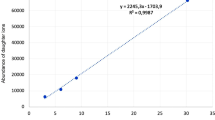Abstract
Four strains of Ascochyta rabiei pathogenic to chickpea (Cicer arietinum L.) were shown to efficiently degrade medicarpin (3-hydroxy-9-methoxypterocarpan), the main phytoalexin of this plant. Degradative studies were performed with mycelium preparations or with crude protein extracts of the fungus. Isolation and structural elucidation of 10 catabolites by chromatographic and spectroscopic techniques revealed that medicarpin degradation involves 1. reductive conversion to a 2′-hydroxyisoflavan, 2. O-demethylation, 3. aromatic hydroxylation in ring A and 4. formation of a 1a-hydroxy-pterocarp-1,4-diene-3-one. As terminal aromatic catabolite 2,4-dihydroxybenzoic acid was found. A catabolic sequence for medicarpin is postulated and the results are discussed with regard to pterocarpan dissimilation by other phytopathogenic fungi.
Similar content being viewed by others

References
Barz W, Willeke U, Weltring K-M (1980) Microbial degradation of phytoalexins and related compounds. Ann Phytopathol 12:435–452
Blau K, King GS (1977) Handbook of derivatives for chromatography. Heyden, London
Chimura H, Sawa T, Kumada Y, Naganawa H, Matsuzaki M, Takita T, Hamada M, Takeuchi T, Umezawa H (1975) New isolfavones, inhibiting catechol-O-methyltransferase, produced by Streptomyces. J Antibiotics XXVIII:620–626
Darvill AG, Albersheim P (1984) Phytoalexins and their elicitors. A defense against microbial infection in plants. Ann Rev Plant Physiol 35:243–275
Denny TT, VanEtten HD (1981) Tolerance by Nectria haematococca MP VI of the chickpea (Cicer arietinum) phytoalexins medicarpin and maackiain. Physiol Plant Pathol 19:419–437
Denny TP, VanEtten HD (1982) Metabolism of the phytoalexin medicarpin and maackiain by Fusarium solani. Phytochemistry 21:1023–1028
Dixon RA, Dey PM, Lamb CJ (1983) Phytoalexins: enzymology and molecular biology. Adv Enzymol 55:1–136
Duczek LJ, Higgins VJ (1976) The role of medicarpin and maackiain in the response of red clover leaves to Helminthosporium carbonum, Stemphylium botryosum, and S. sarcinaeforme. Can J Bot 54:2609–2619
Higgins VJ (1975) Induced conversion of the phytoalexin maackiain to dihydromaackiain by the alfalfa pathogen Stemphylium botryosum. Physiol Plant Pathol 6:5–8
Ingham JL (1976) Fungal modification of pterocarpan phytoalexins from Melilotus alba and Trifolium pratense. Phytochemistry 15:1489–1495
Kraft B, Barz W (1985) Degradation of the isoflavone biochanin A and its glucoside conjugates by Ascochyta rabiei. Appl Environm Microbiol 50:45–58
Kuć J, Rush JS (1985) Phytoalexins. Arch Biochem Biophys 236:455–472
Mabry TJ, Markham KR, Thomas MB (eds) (1970) The systematic identification of flavonoids. Springer, Berlin Heidelberg New York
Mansfield JW (1982) The role of phytoalexins in disease resistance, In: Bailey JA, Mansfield JW (eds) Phytoalexins. Blackie and Sons, Glasgow, pp 253–280
Nene YL (1982) A review of Ascochyta blight of chickpea. Trop Pest Managem 28:61–70
Platero Sanz M, Fuchs A (1978) Degradation of pisatin, an antimicrobial compound produced by Pisum sativum L. Phytopathol Mediterr 28:61–70
Smith DA, Wheeler HE, Banks SW, Cleveland TE (1984) Association between lowered Kievitone hydratase activity and reduced virulence to bean in variants of Fusarium solani f. sp. phaseoli. Physiol Plant Pathol 25:135–147
Umezawa H, Tobe H, Shibamoto N, Nakamura F, Nakamura K, Matsuzaki M, Takeuchi T (1975) Isolation of isoflavones inhibiting dopa decarboxylase from fungi and Streptomyces. J Antibiotics XXVIII:947–952
VanEtten HD (1982) Phytoalexin detoxification by monooxygenases and its importance for pathogenicity. In: Asada Y, Bushnell WR, Ouchi S, Vance CP (eds) The physiological and biochemical basis of plant infection. Japan Scient Societies Press and Springer, Berlin Heidelberg New York, pp 315–327
VanEtten HD, Matthews DE, Smith DA (1982) Metabolism of phytoalexins. In: Bailey JA, Mansfield JW (eds) Phytoalexins. Blackie and Sons, Glasgow pp 181–217
VanEtten HD, Matthews PS, Mercer EH (1983) (+)-Maackiain and (+)-medicarpin as phytoalexins in Sophora japonica and identification of the (+)-isomers by biotransformation. Phytochemistry 22:2291–2295
Weigand F, Köster J, Weltzien HC, Barz W (1986) Accumulation of phytoalexins and isoflavone glucosides in a resistant and a susceptible cultivar of Cicer arietinum during infection with Ascochyta rabiei. J Phytopathol 115:214–221
Weltring K-M, Barz W (1980) Degradation of 3,9-dimethoxypterocarpan and medicarpin by Fusarium proliferatum. Z Naturforsch 35c:399–405
Weltring K-M, Barz W, Dewick PM (1981) Degradation of 3,9-dimethyoxypterocarpan and medicarpin by Fusarium fungi. Arch Microbiol 130:381–384
Weltring K-M, Mackenbrock K, Barz W (1982) Demethylation, methylation and 3′-hydroxylation of isoflavones by Fusarium fungi. Z Naturforsch 37c:570–574
Weltring K-M, Barz W, Dewick PM (1983) Degradation of the phytoalexin medicarpin by Fusarium oxysporum f. sp. lycopersici. Phytochemistry 22:2883–2884
Willeke U, Barz W (1982) Catabolism of 5-hydroxyisoflavones by fungi of the genus Fusarium. Arch Microbiol 132:266–269
Woodward MD (1980) Detection and estimation of phaseollin and other 5-deoxyisoflavonoids in inoculation droplets by selected ion monitoring. Physiol Plant Pathol 17:17–31
Woodward MD (1981) Differentiation of dihydroxy-monomethoxyisoflavones by gas chromatography-mass spectroscopy. Phytochemistry 20:532–534
Woodward MD (1982) Gas chromatography/Mass spectroscopy of isoflavones and related compounds. Phytochemistry 21:1403–1407
Author information
Authors and Affiliations
Rights and permissions
About this article
Cite this article
Kraft, B., Schwenen, L., Stöckl, D. et al. Degradation of the pterocarpan phytoalexin medicarpin by Ascochyta rabiei . Arch. Microbiol. 147, 201–206 (1987). https://doi.org/10.1007/BF00415285
Received:
Accepted:
Issue Date:
DOI: https://doi.org/10.1007/BF00415285



